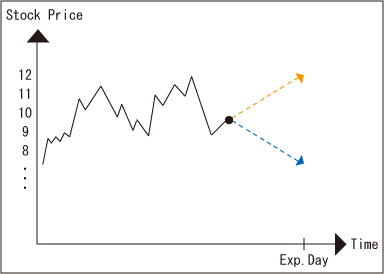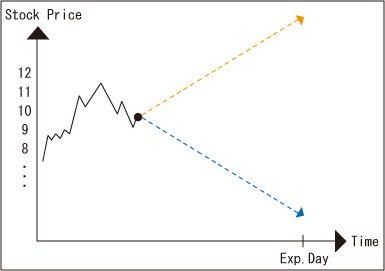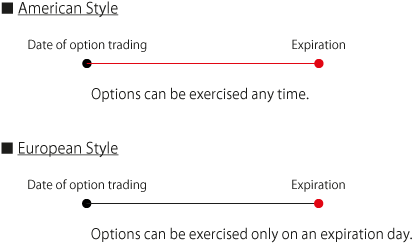6. Intrinsic Value and Time Value


So far, we have learned the basics of options.

What I have learned is ...
There are two kinds of options, Call and Put. Call is a right to buy something, and Put is a right to sell something on a certain day.
There are two kinds of options, Call and Put. Call is a right to buy something, and Put is a right to sell something on a certain day.

Good job.
To better understand how prices of options are determined, however, you need to know Intrinsic Value and Time Value.
To better understand how prices of options are determined, however, you need to know Intrinsic Value and Time Value.
(1). In the Money, At the Money, or Out of the Money

First, let's look at the following example. It shows 3 kinds of call options.
(In and Out are reversed for put options.)

(In and Out are reversed for put options.)


On September 1, let's suppose that there are 3 kinds of call option for a stock which is currently trading at $10 per share. The strike prices of these options are $9, $10, and $11. They all expire on October 1. (a month later)
If you have the call with $9 strike price, you can buy the stock for $9 although its current price is $10 at the market. In this sense, the option already has a real value.
In the language of options traders, such options are called in-the-money options. The value that in-the-money options have is called intrinsic value.
In the above examble, the call with $9 strike price has intrinsic value of $1.
If you have the call with $9 strike price, you can buy the stock for $9 although its current price is $10 at the market. In this sense, the option already has a real value.
In the language of options traders, such options are called in-the-money options. The value that in-the-money options have is called intrinsic value.
In the above examble, the call with $9 strike price has intrinsic value of $1.

Well, if I have that option, I can buy the stocks for $9 per share and sell them immediately for $10 to make a profit of $1 per share. This profit of "$1 per share" is called intrinsic value, correct?

That's right. Intrinsic value is calculated by [current stock price - call strike price] or [put strike price - current stock price].
Another way of remembering is simply "the profit you can get if you exercise the option right away".
If [current stock price = call or put strike price], the option is called an at-the-money option.
In the above examble, the call with $10 strike price is categorized as an at-the-money option.
At-the-money options do not have an intrinsic value.
Another way of remembering is simply "the profit you can get if you exercise the option right away".
If [current stock price = call or put strike price], the option is called an at-the-money option.
In the above examble, the call with $10 strike price is categorized as an at-the-money option.
At-the-money options do not have an intrinsic value.

If you pay $10 to buy $10 stock, you gain nothing.

It's no better than simply buying the stock like other investors do.
Finally, let's look at the call option with $11 strike price. This option won't have a real value until the stock price rises above $11.
Such options whose strike prices are out of the current stock price are called out-of-the-money options.
Of course, out-the-money options do not have an intrinsic value.
At-the-money options and out-the-money options only have an expectation; an expectation that the underlying stock price might move favorably and bring a value to the option in the future, or Time Value in the option traders' language.
Finally, let's look at the call option with $11 strike price. This option won't have a real value until the stock price rises above $11.
Such options whose strike prices are out of the current stock price are called out-of-the-money options.
Of course, out-the-money options do not have an intrinsic value.
At-the-money options and out-the-money options only have an expectation; an expectation that the underlying stock price might move favorably and bring a value to the option in the future, or Time Value in the option traders' language.
* Intrinsic Value and Time Value (Call options for the $10 stock)
| Strike Price | Category | Premium (Option Price) |
Intrinsic Value | Time Value (Premium - Intrinsic Value) |
|---|---|---|---|---|
| $9 | In the money | $1.7 | $1 ($10 - $9) |
$0.7 ($1.7 - $1) |
| $10 | At the money | $1 | 0 | $1 ($1 - 0) |
| $11 | Out of the money | $0.6 | 0 | $0.6 ($0.6 - 0) |

As mentioned above, intrinsic value of a call option is calculated by [current stock price - strike price]. If the result is less than zero, the option doesn't have intrinsic value, which means the premium of the option is all time value.
Conversely, intrinsic value of a put option is calculated by [strike price - current stock price].
Time value is a price of an expectation that an underlying stock price might move favorably and bring a value to the option in the future. The longer the time to exercise, the higher the chance of this occurring, and thus the higher the time value.
Conversely, intrinsic value of a put option is calculated by [strike price - current stock price].
Time value is a price of an expectation that an underlying stock price might move favorably and bring a value to the option in the future. The longer the time to exercise, the higher the chance of this occurring, and thus the higher the time value.
* Options of near expiration month

- With short period of time until expiration, there is little chance that a stock price moves significantly.
- Traders have low expectations that the value of the option will increase before expiration.
- Time Value is low.
* Options of far expiration month

- With long period of time until expiration, there is good chance that a stock price moves significantly.
- Traders have high expectations that the value of the option will increase before expiration.
- Time Value is high.

As options near the expiration, the expectation (time value) is becoming smaller.

And eventually, time value of an option becomes zero on an expiration day.
The graph below shows how an option's time value decreases as time goes by.
Time value decreases at a slow pace at first, and then sharply decreases near the expiration day.
The decrease of an option's time value as time passes is called Time Decay.
The graph below shows how an option's time value decreases as time goes by.

Time value decreases at a slow pace at first, and then sharply decreases near the expiration day.
The decrease of an option's time value as time passes is called Time Decay.

Time value becomes zero in the end, right?
So only intrinsic value remains on an expiration day?
So only intrinsic value remains on an expiration day?


I see. But I'm not quite sure how this time value thing affects trading.

After you buy an out-of-the-money option, for example, you can decide to sell it away before time value decays sharply when the market doesn't move as you expected.
Or if you sell an option, time decay works in your favor because the option's value decreases as expiration nears.
Time decay is a risk element for option buyers, but an edge to be used for option sellers.
Or if you sell an option, time decay works in your favor because the option's value decreases as expiration nears.
Time decay is a risk element for option buyers, but an edge to be used for option sellers.

Well, it does affect both sides of a trade.
(2). How options are exercised - American Style and European Style

Having learned time value, it's time to know the "style" of option exercise.
There are 2 kinds of option exercise -- American Style with which options can be exercised any time before expiration, and European Style with which options can be exercised only on an expiration day.

There are 2 kinds of option exercise -- American Style with which options can be exercised any time before expiration, and European Style with which options can be exercised only on an expiration day.


Which style is better for traders?

Buyers of options can exercise American-style options whenever they want.
In exchange for that, however, a premium of an American-style option tends to be higher than that of an European-style option. So it's hard to say which style is better.
Most of the options traded in the U.S. market are American-style options including stock options, futures options, and the major index options.
It's important that you know the style of the exercise before trading options.
In exchange for that, however, a premium of an American-style option tends to be higher than that of an European-style option. So it's hard to say which style is better.
Most of the options traded in the U.S. market are American-style options including stock options, futures options, and the major index options.
It's important that you know the style of the exercise before trading options.

I got it. I'll check it when I trade options.
- 1. Advantages of Options
- 2. Basics of Options
- 3. Call Option
- 4. Put Option
- 5. Summary of Basics
- 6. Intrinsic Value and Time Value
- 7. Cover Call
- 8. What is Volatility?
- 9. How to take advantage of volatility

